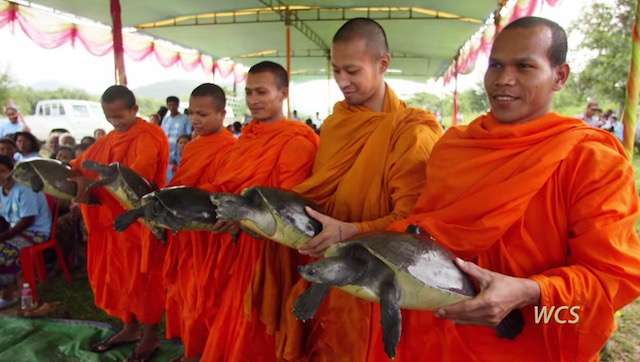Success: Green Sea Turtles of Florida and Mexico No Longer Endangered
Years of coordinated conservation efforts have paid off for the green sea turtle populations in Florida and the Pacific coast.

14 years ago, conservationists were overjoyed to come across three "royal turtle" nests. The 3-5 females and their mates and offspring were believed to be the only ones left in Cambodia.
For 100 years in that country there had been no recorded sightings of the once-common southern river terrapin, but the species' population is growing again thanks to wildlife officials, a group of Buddhist monks, and former turtle hunters who are now paid to guard the nests they once raided.
Since that day in 2001, the Wildlife Conservation Society (WCS) has been working with Cambodia's Fisheries Administration in a captive breeding program. The partners have been raising the hatchlings to keep them away from predators while they grow, both in the town of Sre Ambel, and outside the country-in Thailand and Singapore-to guard against a catastrophic event or typhoon that could wipe out all the animals.
Buddhist monks have also played a key role in convincing villagers to leave the turtles alone.
"In Cambodian society, Buddhism is a very important part of the culture, and monks are revered and respected," said Brian Horne, a representative for the WCS. "So when the local monks join in and say, 'Don't go out and harm these turtles,' generally people listen."
In July, a group of monks led a traditional ceremony in front of 150 people to bless the 21 turtles (scientific name: Batagur affinis) that had been raised in captivity before releasing them into their native habitat in the Sre Ambel River system.
The terrapins, once called "royal turtles" and declared the property of the king, were designated in 2005 as the national reptile of Cambodia to raise awareness of the conservation effort.
As one of the largest herbivores in the river, the species is crucial to the health of the entire ecosystem. So, in 2001, when the nests were discovered, the WCS and wildlife officials began a community based protection program to ensure their survival. Turtle hunters were enlisted and paid to protect the nests, which grew in number to 39. Hundreds of hatchlings were raised in facilities and, finally, this group of 21 was chosen as the most genetically diverse and first to be released since the program started.
(WATCH the WCS video ) - Photos: Wildlife Conservation Society video
SHARE the Good News About One of the Rarest of Turtles in the World: (Click below)
Be the first to comment